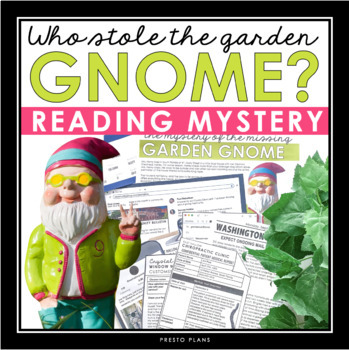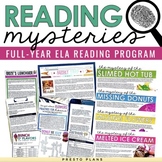Close Reading Mystery Inference Text Evidence Activity - Who Stole the Gnome?
- Zip
Also included in
- The Reading Mysteries Program is a full-year, 40-week close reading program for middle and high school English language arts teachers that challenges students to look for text evidence, infer information, and read more closely. It includes everything you need to facilitate 40 fun and engaging readinPrice $99.99Original Price $196.61Save $96.62
Description
Close Reading Mystery Inference Text Evidence Activity - Who Stole the Gnome?: Engage your students with a captivating close reading inference activity that challenges them to explore and find text evidence, make inferences, and read more closely. This resource provides all the necessary materials to facilitate this fun and creative reading activity in your classroom. Students will have the opportunity to work collaboratively, enhancing their problem-solving and critical-thinking skills as they unravel the mystery together.
Mrs. Henry lives alone with her dog in a small South Florida home. Her most prized possession is her garden gnome which she has named Gerome. After returning from groceries one night, Mrs. Henry notices that the garden gnome is missing from her yard. Someone stole Gerome, and your students need to figure out who did it.
This is included in our best-selling full-year program:
Included In This Close Reading and Text Evidence Inference Mystery Activity:
➡️ Inference Mystery Presentation Slides: This 15-slide PowerPoint presentation serves as the guide for the activity, leading students through the mystery with a captivating backstory, detailed evidence, and thorough explanations for each suspect's innocence or guilt. The slides are crafted to engage students and encourage critical thinking as they analyze the clues and find text evidence.
➡️ Classroom Poster: Display this visually appealing poster designed to grab students' attention as they enter the classroom, setting the stage and drawing students into the mystery ahead.
➡️ Original Narrative Backstory: Use this short story to introduce the mystery. Within the story are hidden clues and subtle hints, and the narrative will engage students' curiosity and initiate the mystery.
➡️ A Variety of Clues and Evidence: Students will receive a variety of texts in different forms that include clues and evidence. Students must read the text closely and use their inference skills to analyze each of the clues. There is a bylaw infraction notice, a social media profile, a package delivery information page, an airplane ticket, a customer feedback form, a chiropractor medical report, an email, a veterinarian medical report, a community social media group, and a newspaper article.
➡️ Text Evidence Graphic Organizer: Students will use the provided graphic organizer to organize their findings and evaluate the guilt or innocence of each suspect. This tool encourages students to support their conclusions with text evidence from the investigation.
➡️ Teacher Answer Key: Use the detailed answer key, both in print format and integrated into the presentation slides, to efficiently review students' work and share the reasons for each suspect's innocence or guilt.
How The Close Reading and Text Evidence Inference Mystery Activity Works:
- Start by putting up the poster on your door to build anticipation when students enter the room. When students enter, put them in small groups, so they can work together to try to solve the mystery.
- Use the presentation slides to guide you through each element of the lesson. The slides will help you introduce the story and evidence to each of the groups.
- Hand out all the evidence to students and allow them time to make their predictions and inferences and solve the mystery.
- Once each group has made their final prediction, use the presentation slides to reveal the culprit and go through each of the suspects to show the evidence of their innocence or guilt.
What Teachers Are Saying About The Close Reading and Text Evidence Inference Mystery Activity:
⭐️⭐️⭐️⭐️⭐️ Great resource to add with others when I was out of school for a day for my students to review the lessons we had just completed.
⭐️⭐️⭐️⭐️⭐️ This is the second "Who Stole..." activity that I have used with my students. My students are extremely engaged and interested to see how the activity unfolds. Look forward to using more.
⭐️⭐️⭐️⭐️⭐️ My students absolutely love these mystery resources. They totally get into solving them first and gloating to their friends that they're the "better detective."
If you like this, you’ll love this resource:
>>> Inference Activities Bundle
© Presto Plans
➡️ Want 10 free ELA resources sent to your inbox? Click here!
⭐️ Follow Presto Plans on TpT to see what's new and on sale.






